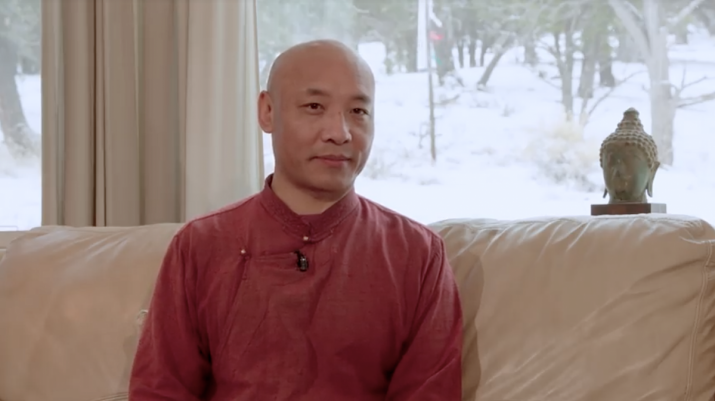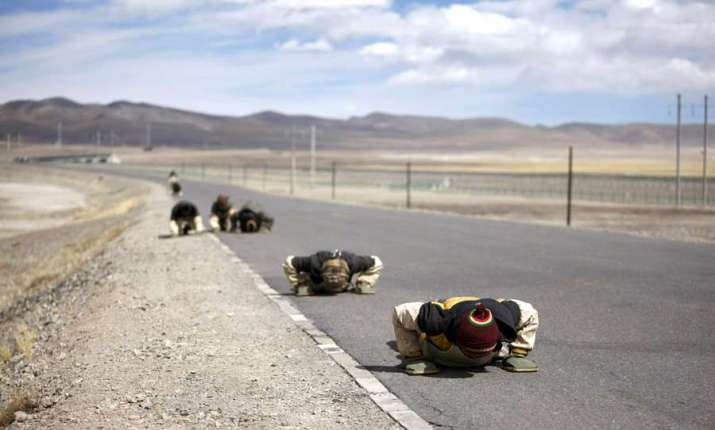FEATURES|COLUMNS|Dharma Gossip
Pilgrimage
 Anam Thubten Rinpoche. From youtube.com
Anam Thubten Rinpoche. From youtube.comMany modern people who practice spirituality in a nontraditional or more secular fashion might not think about visiting a shrine or holy site, although they may go away from their homes to spend time in nature or participate in meditation retreats for period of time. Going to see some famous historic religious sites as a tourist might not count as pilgrimage, however.
Notre-Dame of Paris, the Potala Palace, the Ajanta Caves, and Borobudur attract many people who are purely interested in the historical significance or outstanding architecture; their only “prayers” might be to take some photos. The same people who visit Notre-Dame will also go to the Louvre Museum and see the Mona Lisa for the same purpose of cultural exploration; they may also stay in luxurious hotels and try expensive French wine and cheese. Flocks of tourists paying visits to Grauman’s Chinese Theatre in Hollywood to behold the footprints of movie stars and starlets, or going to the headquarters of world-renowned corporations such as Google to get a selfie next to the logo, don’t have anything in their mind that has to do with sacred.
The idea of pilgrimage is becoming increasingly antiquated and irrelevant to the younger generation in some parts of the world. Yet there are also many cultures today where pilgrimage is as alive as it always has been. It is an important observance for many Buddhists across diverse traditions. Millions of Buddhists aspire to see Bodh Gaya, where Shakyamuni Buddha became awakened under a tree. Once they get there, they don’t just spend time taking pictures, nor do they wine and dine; if they do, it is just a supplemental activity. Their main objective is to pray and meditate; to experience karmic purification and gain wisdom and insight into the nature of reality.
Because of modern conveniences, the quality of pilgrimage is becoming watered down. Taking a flight or a train, with constant access to food and restaurants, and having a hotel with countless amenities, is how many travel to see these ancient sites. It can be too comfortable and mechanical in comparison to the way people did it in the old days.
Before the modern era, people in Tibet would walk for days with only simple comforts to reach a holy site. They would usually carried staples themselves, or bring an animal to carry their basic necessities. For them, the starting point of their journey was as important as arriving at the destination. The whole journey was dedicated as a spiritual practice, with a daily focus on prayer and meditation. These pilgrims often went through an authentic conversion on such a journey, which was the initial intention that inspired them in the first place. Nowadays, fewer and fewer have the willingness to follow in the footsteps of those pilgrims of the past; today everything is expected to happen quickly and comfortably—including enlightenment.
A favorite memory that still revisits me after many years is walking in the snowy Himalaya on a pilgrimage as a young boy, making tea in the open air by boiling water from fresh rivers flowing down from the high mountains; eating tsampa while laughing with friends; reciting mantras that invoked connection with the sacred and love; and the ecstasy of seeing the holy mountains and images, washing the heart of all its pains. These are priceless moments that cannot be recreated easily at personal will, due to the impact of the time we are living in today, an era of comfort and technology.
Now and then, a deep grief arises in me over loss of these old traditions. Some of the people who walked with me are gone from this world. Yet I wish their beautiful memory of such a journey is still traveling somewhere in the universe, even though their physical forms are already dissolved. Many memorable moments can never be fully captured or described in any way unless one has been in that specific time and place.
 Tibetan Buddhist pilgrims prostrate themselves along a road during their journey to Lhasa. From chinadaily.com.cn
Tibetan Buddhist pilgrims prostrate themselves along a road during their journey to Lhasa. From chinadaily.com.cnIt might have to do with being brought up in a Buddhist culture that many of us feel the sense of the sacred upon visiting holy sites in the East. Unlike other parts of the world, Asia is full of Buddhist holy sites associated with buddhas and bodhisattvas. They are everywhere in China, India, Japan, and Korea. In the last few years, my friends have taken me to some sites in Asia that are historical as well as blessed by great masters of the past. A feeling of pure joy arises in me each time I visit them; I feel I’m embraced by something utterly wholesome. Sometimes I wish that there were Buddhist holy sites in the West where we could go on a pilgrimage and feel the same kind of blessing. Some might say that if our mind is open enough, anywhere can be a holy site.
I have had the good fortune to travel to the heart of Canyon De Chelly in the US a few times to do Chod retreats with some wonderful friends. The inside of the canyon is quite rugged and devoid of any touch of modernity. We hiked a few hours both ways, going in and coming out. Each of us brought our camping tents and gear, along with simple food. I ate lots of ramen noodles for their convenience, which is not part of my usual daily diet. Almost every day, we took long walks then sat and performed rituals. To me, it was such a powerful pilgrimage that words cannot describe its full impact, which is still continuing in me. There are a few memories that I would like to cherish for the rest of my life. This is one of them.
In the end, pilgrimage is not so much about feeling holy or encountering divine visions along the way, but it is an invitation to each of us to look into all our attachments and let go of them. Can we experience a profound sense of letting go with all the comforts that are part of a modern pilgrimage? We might like to try to keep the tradition of ancient pilgrims that can help us go through life changing experience by dropping our inner bondage.
See more
Related features from Buddhistdoor Global
The Heart of Pilgrimage
Searching for the Lotus-Born Master: Following the Father of Vajrayana Buddhism’s Journey Across the Himalayas
Ritualized Landscapes: Performative Iconography
Preserving the Buddha’s Birthplace: A Case Against a Spiritual Disneyland














